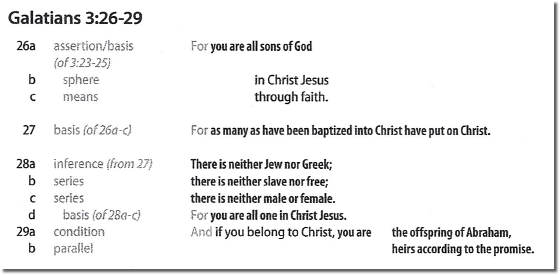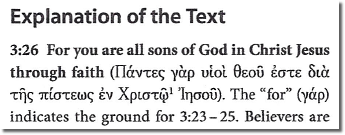Book Review - Zondervan Exegetical Commentary on the New Testament: Galatians
[amazon 0310243726 thumbnail]
The Zondervan Exegetical Commentary on the New Testament is a newer series of solid, scholarly and evangelical commentaries. I am pleased to provide a brief overview of the series using Thomas Schreiner’s contribution on Galatians as an example.
The ZECNT is a commentary series whose unusual structure and features make it unique. Future commentary series will have to take this format into consideration as they try to develop a comparable model. Though these are exegetical commentaries on the Greek text, those who are either uneducated in Greek or who are loosely familiar with it will still find much of benefit. The final form of the ZECNT series “was refined over time by an editorial board who listened to pastors and teachers express what they wanted to see in a commentary series based on the Greek text (p. 9).” I believe the editors of the ZECNT have lived up to that desire.
The ZECNT series follows a seven-fold outline form for each chapter. Here, we will explain each part of the outline and provide a sample of what it looks like from the chapter on Galatians 3:26-29.
1. Literary Context
Each chapter starts out by setting the Literary Context. The context of each pericope is explained in one or more paragraphs. Following the explanation the author places the pericope within the larger context of the whole book in outline form. Example: Following Paul’s argument in Galatians 3:1-25 concerning the nature of the law in relation to the promises of God, Paul now moves to show “that the law as a pedagogue is now passed since all believers are now God’s sons and daughters in Christ through faith (p. 253).” All believers, Gentiles included, are the promised sons of Abraham by virtue of being in Christ who is Himself the one true offspring of Abraham (3:16).
2. Main Idea
Second, following the literary context is the Main Idea. This section seeks to summarize the central message of each pericope in a few sentences. Example: Schreiner states that the main idea of Galatians 3:26-29 “is that believers are the offspring of Abraham by virtue of their union with Christ Jesus (p. 254).”
3. Translation & Graphical Layout
Third, after the main idea is the Translation & Graphical Layout. In my opinion this is by far the best feature of the ZECNT series, and no other series possesses it to my knowledge. The author’s translation of the passage is presented in a block diagramming fashion. This feature is a benefit to anyone regardless of whether he has knowledge of Greek because it allows readers to see the natural outline of the text as it falls from the grammar. Not only is the translation in outline form, but also each line is given its grammatical function (ground, means, series, condition, etc.). One caution: having all of this exegetical work done for us should not be used as an excuse to neglect our own work.
An example of Schreiner’s graphical layout follows, from Galatians 3:26-29:
4. Structure
Once the translation and graphical outline have been established, we move to the structure of the passage. This section provides a brief commentary on the grammatical features of the pericope as outlined in the graphical layout. It seeks to summarize and interpret the meaning and significance of the different clauses within the pericope. Example: Schreiner points out the grounding nature of the three “for” (gar) clauses (26a, 27 & 28d). The conditional clause in 29a serves as the climax to the whole pericope as Schreiner states, “Those who belong to Christ, who is the true offspring of Abraham, are also part of Abraham’s family. They are the true offspring of Abraham (p. 255).”
5. Exegetical Outline
After a more detailed look at the pericope, the writer focuses on how each passage fits into the overall flow of the book by placing it in the Exegetical Outline. This outline is similar to the outline in the literary context section but is narrower in focus. For example, Schreiner designates Galatians 3:1-4:11 as the second major movement (II) in Galatians and titles it “Paul’s Gospel Defended from Experience and Scripture.” The third section (C) within this movement covers 3:15-4:11 and is titled “Argument from Salvation History: Priority of Abrahamic Covenant and temporary Nature of Mosaic Covenant.” Galatians 3:26-29 is the second (2) part of “C” and is labeled “Sons of God are Abraham’s offspring.”
6. Explanation of the Text
Sixth, since this is an exegetical commentary, the bulk of each chapter is devoted to a verse-by-verse Explanation of the Text. For each verse the author’s translation is placed first in highlighted lettering followed by the Greek text in parenthesis. Following this is the author’s commentary on each verse. An example appears below.
7. Theology in Application
Each chapter closes with a Theology in Application section. While this volume’s application section is not unique among commentaries (e.g., NIV Application Commentary), it is fairly unusual in an exegetical commentary. Example: Schreiner concludes (correctly) from this passage that all believers are one and equal in Christ. There is no spiritual hierarchy in the mind of God towards his children. Race and gender do not play a role in gaining greater standing with God. Though all believers are equal in Christ, this equality does not erase the natural differences which God has created us with (such as gender or ethnicity). Schreiner makes this statement in response to feminist theology which uses this passage to remove distinctions between gender roles in the church. Schreiner points out that Paul’s equality language is set in the context of salvation in Christ, which does not imply that gender and ethnicity differences no longer exist. All people are equal in essence as persons and yet unique and distinct in their God-given roles and personal qualities.
Overall, the ZECNT series provides some needed features that tend to be lacking in too many commentaries. The Graphical Outline and Structural Commentary are the distinguishing features of the SECNT series. A solid introduction covers the typical issues of authorship, dating, audience, background, etc. Schreiner takes a complementarian view on the example chapter on Galatians 3:26-29 and does a good job of handling the issues regarding Paul and the Law. Those who like Schreiner and are interested in further study of the Law would also benefit from Schreiner’s recent coauthored book 40 Questions About Christians and Biblical Law in the new 40 Questions and Answers Series.
CPHurst Bio
Craig Hurst received his BA in Church Ministries from Clearwater Christian College and his MA in theology at Calvary Baptist Theological Seminary in Lansdale, PA. He currently lives outside of Grand Rapids, MI and attends Grace Community Church, where he serves as a volunteer youth worker (along with his wife), and teaches some elective classes. He blogs at Theology for the Road.
- 154 views
This is a fantastic review with a great deal of detail to guide interest. Thank you for the additional information on Schreiner. The graphical layout is well thought out.
My Blog: http://dearreaderblog.com
Cor meum tibi offero Domine prompte et sincere. ~ John Calvin
Thanks for the review. Through your encouragement, I am going to order this tool.
et
I agree that the layout of this commentary invites exegetical study rather than doles out knowledge from the esteemed author. The style encourages pastors and students to “go up higher” and grapple with the issues for themselves. Also periodically it includes “in depth” sections that focus in on more specific questions at length, such as “the Israel of God” in Gal. 6:16.
It’s a great commentary, glad Sharper Iron was able to feature it too. Thanks Craig for your work on the review, too.
Striving for the unity of the faith, for the glory of God ~ Eph. 4:3, 13; Rom. 15:5-7 I blog at Fundamentally Reformed. Follow me on Twitter.
Why is it that my voice always seems to be loudest when I am saying the dumbest things?
[Charlie] I want to point out that Schreiner follows a similar format in his other commentaries. His Romans commentary (BECNT?) was remarkable for its focus not on verses, but on passages.Schreiner teaches that one cannot properly understand the verse apart from the broader context of the paragraph and surrounding paragraphs. This is why he exegetes the way he does.
For more information on his methodology, you can read these resources:
http://www.sbts.edu/documents/tschreiner/book_IPE_chapter5.pdf
http://www.sbts.edu/documents/tschreiner/book_IPE_chapter6.pdf










Discussion